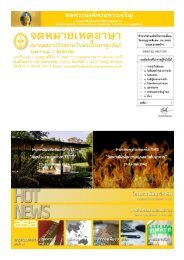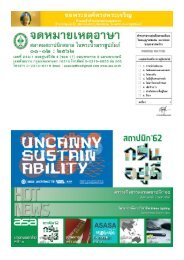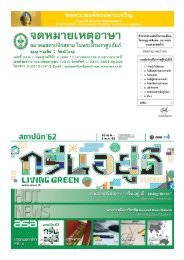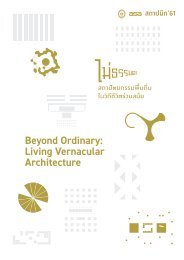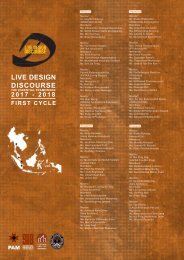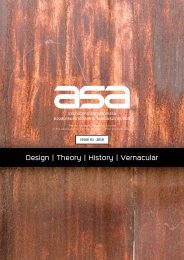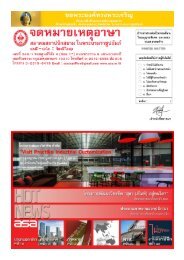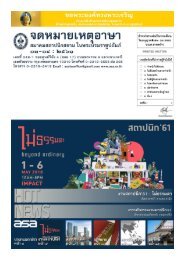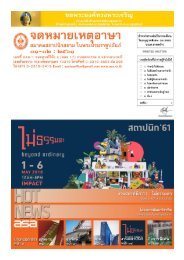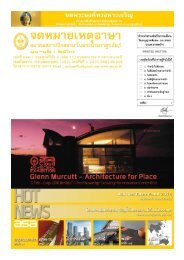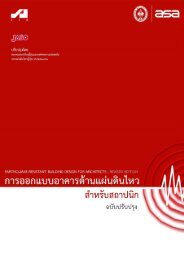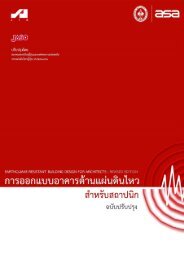ASA JOURNAL Vol.2 | 2018
You also want an ePaper? Increase the reach of your titles
YUMPU automatically turns print PDFs into web optimized ePapers that Google loves.
Adaptive Reuse of Old Buildings in Thailand: From Conservation to<br />
Adaptation to Socio-Economic Situations and Architectural Design<br />
Challenges<br />
Saithiwa Ramasoot, Ph.D<br />
Department of Architecture, Faculty of Architecture, Kasetsart University / archstw@ku.ac.th<br />
Abstract<br />
Adaptive reuse is a process of returning an active use to an existing building, which usually involves varying physical<br />
modifications along with an introduction of new functions different from its original design. Thailand has seen the practice<br />
long before recent extensive implementations as an approach to preserve cultural heritage and architectural values as well as<br />
to generate economic benefits from available resources. This article aims to study development of adaptive reuse of old<br />
buildings in Thailand with diverse causes and objectives. It reviews and analyzes patterns of the practices over time, while<br />
identifying issues, factors, phenomena and situations related to building conversions through literature review, observation<br />
and survey of situations and case studies. The study points out that functional adaptation in the past usually involved cultural<br />
and social factors. Architectural hierarchy related to social ranking, history, building owners and original uses was often<br />
considered in conservative adaptations of historical artifacts. However, more recent approaches tend to open for creative<br />
challenges and welcome design interpretations to promote contemporary potential of old buildings. The broad and diverse<br />
implementations include varying types and characteristics of buildings to convert, new uses to introduce, and related physical<br />
interventions. Conversion purposes no longer limit to architectural conservation and urban regeneration, but extend to<br />
adapt and respond to present conditions including social, environmental, economic and tourism issues. Adaptive reuse is then<br />
considered an interesting approach to retain a good balance between conservation and development, while responding to<br />
changing needs and contexts due to the flexibility and diversity of the implementations.<br />
Keywords: Adaptive reuse, architectural conservation, old buildings, rehabilitation<br />
Introduction<br />
The development of architectural projects that involve<br />
old or existing buildings within site contexts is common in<br />
today’s practice. Functional conversion with physical improvement<br />
is among interventions introduced to old buildings that are<br />
originally designed and used for other purposes but may no<br />
longer fully meet present needs and tastes. Such intervention<br />
preserves architectural heritage with values and functional<br />
potential by prolonging its life through interpretation and<br />
physical changes. It is also applied to contemporary buildings<br />
in various conditions in order to serve building and site potentials,<br />
respond to specific issues and express creativity in utilizing<br />
existing resources and reducing consumption of new resources<br />
for environmental sustainability. (Charles Bloszies, 2012) This<br />
article thus aims to study development of adaptive reuse of old<br />
buildings in Thailand that is diversely implemented with<br />
different causes and objectives. It analyzes patterns of adaptive<br />
reuse practices over time and points out issues, factors, phenomena<br />
or interesting situations related to building conversions through<br />
92<br />
วารสารสถาปัตยกรรมของสมาคมสถาปนิกสยาม<br />
ในพระบรมราชูปถัมภ์ Issue 02 / <strong>2018</strong><br />
Academic Journal of The Association of Siamese Architects<br />
under the Royal Patronage<br />
literature review, and observation and survey of situations and<br />
case studies.<br />
Adaptive Reuse or Adaptive Use refers to the process of<br />
converting a building to another use different from its original<br />
design, which often requires varying alterations in the conversion<br />
process. (William J. Murtagh, 1997: 116) It is an economic<br />
approach to save the buildings through adaptations for new<br />
users (James Marston Fitch, 1995: 47) sometimes involving<br />
radical interventions when compared to conservation, restoration<br />
and preservation. Apart from adaptive reuse, several other terms<br />
are widely used when it comes to modifications to improve old<br />
structures, including Renovation, Rehabilitation, Revitalization,<br />
Adaptation, Conversion and Repurposing. All of which refer to<br />
attempts to change parts of old buildings to support present-day<br />
needs with minimal physical changes to the buildings. (Pinraj<br />
Khanjanusthiti, 2009: 86-87) Such process is another approach<br />
to safeguard old buildings as a useful living heritage rather than<br />
the so-called dead monument of the past that lacks linkage to<br />
contemporary cultures. The change of use provides economic<br />
opportunities for old structures or districts, although the<br />
conversion does not necessarily reduce construction cost. Also,<br />
the success of preservation of value and authenticity of the old<br />
artifacts may differ depending on actual implementations in<br />
each case.<br />
Transfers of Old Houses by Tradition<br />
Functional conversion of old buildings have long been<br />
practiced in Thailand due to tradition, belief and purpose to<br />
make use of existing resources. A common building type that<br />
transfers and adapts to a new use is the traditional Thai house,<br />
as confirmed by various existing examples. The Thai house is<br />
a basic dwelling type that can be dismantled and reassembled<br />
without any damage due to the prefabricated structure and<br />
wood joinery techniques. Therefore, house relocation and<br />
family expansion that require changes and addition of house<br />
units can be accommodated. In the past, when the original<br />
house owner passed away and his successors refused to take<br />
over the house, the house may be dissembled and donated to<br />
a temple as merit making for the deceased. The temple would<br />
then rebuild and adapt the structure as it is deemed appropriate,<br />
depending on its size and qualities. Small houses were<br />
often reused as monks’ dwelling units while larger or more<br />
elegant houses were sometimes converted into ordination halls,<br />
Vihara or scripture halls. Existing examples are the Sermon<br />
Hall at Wat Yai Suwannaram in Petchaburi, the Scripture Hall<br />
at Wat Rakhang Kositaram in Bangkok, and the Vihara of Wat<br />
Pantao in Chiangmai. The adaptive reuse of the traditional<br />
Thai house is still in practice today while the traditional beliefs<br />
regarding house transfer in the past are not as strict as before.<br />
Adaptable physical characteristics of the traditional Thai house<br />
architecture greatly facilitate its adaptation. (Saithiwa<br />
Ramasoot, 2008) The value of old Thai houses has increased<br />
with the rising trend to reuse the structure and the emergence<br />
of specialized businesses that restore, customize and resell<br />
previously-used Thai houses for contemporary uses, whether<br />
or not for residential purposes. Distinct examples of traditional<br />
Thai houses adapted for contemporary domestic lifestyles<br />
include Plainern Palace and Lada Ratkasikorn’s residence. In<br />
the case of M.R. Kukrit Pramoj’s residence, each house units<br />
in the compound had individual acquisition stories from<br />
different places and times. Not only is the house notable for<br />
modern modifications to achieve comfort and convenience<br />
such as the installations of an elevator, a modern bathroom<br />
and air-conditioning system, but also for its second major<br />
conservation and conversion into a house museum and rental<br />
event space after M.R. Kukrit’s death.<br />
From Royal Palaces and Noble Residences<br />
to Governmental Offices<br />
A governmental office was considered a new building<br />
type in the Thai society during the Rattanakosin Period. Since<br />
palaces in the past acted as both residence and work place for<br />
royalties and high-ranking officials, there was no apparent<br />
evidence of functional and spatial conversions. Not until the<br />
reign of King Rama IV did a number of new governmental<br />
buildings emerge to accommodate newly-established offices<br />
and sectors for updated administrative systems and services.<br />
Most of which were built in large western-style concrete structures.<br />
The constructions then slowed down again during the<br />
reign of King Rama VII owing to the economic regression and<br />
the political change. The ownership of a number of palaces<br />
was transferred to the Government due to a lack of successors<br />
or by confiscation. The vacant palaces and royal residences<br />
were then repurposed for public uses. For example, Suan<br />
Sunandha Palace which was a residential compound and a<br />
part of King Rama V’s Dusit Palace was reused after the<br />
political revolution for educational purposes as Suan Sunandha<br />
Widhyalai School, Suan Sunandha Teachers College and Suan<br />
Sunandha Rajabhat University consecutively. In the case of<br />
Bang Khun Phrom Palace, the former western-style royal<br />
residence served as the site of several governmental offices<br />
after the 1932 revolution such as Department of Military Youth<br />
and National Council of Cultural Affairs. Since 1945, Bang<br />
Khun Phrom Palace has become the headquarters of the Bank<br />
of Thailand. Originally the Royal Palace in the reign of King<br />
Rama V and VI, Phyathai Palace was converted into an international<br />
hotel by the order of King Rama VII and was also the<br />
site of the first Thai radio broadcast station. To utilize the<br />
property for public purposes, King Rama VII changed it again<br />
as a clinic for the Royal Thai Army which later became<br />
Phramongkutklao Hospital. Apart from royal palaces, a number<br />
of noble residences in the past were sold or rented by the<br />
Government and organizations as offices and public facilities.<br />
For example, the western-influenced Ban Manangasila, once<br />
a residence of Phraya Udomratchapakdi, had been converted<br />
to serve different purposes over time, including a guesthouse<br />
for VIPs and official visitors of the Government, a meeting<br />
space, a political party office and presently the Office of the<br />
National Council of Women of Thailand. Chao Phraya Worapongpipat’s<br />
residence, now Ban Phra Arthit, had been rented<br />
as a office of Goethe Institute before it was sold and used as<br />
the headquarter of The Manager Newspaper. The Italiandesigned<br />
Royal Thai Government House Office, widely known<br />
as Thai-Khu-Fah Building, is another adaptive reuse case study




